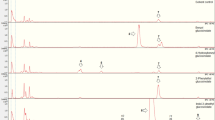Abstract
Oreina cacaliae (Chrysomelidae) sequesters in its elytral and pronotal defensive secretion theN-oxides of pyrrolizidine alkaloids (PAN-oxides) from its food plantAdenostyles alliariae (Asteraceae). [14C]SenecionineN-oxide was applied for detailed studies of PAN-oxide sequestration. An average of 11.4% of total radioactivity is taken up by individual beetles which had received [14C]senecionineN-oxide with their food leaves 8 days before. An average of 28.9% of the ingested radioactivity could be recovered from the defensive secretions collected twice, i.e., 5 and 8 days after tracer feeding. The tracer transfer into the secretion seems to be a slow but progressive process as indicated by the high percentage of tracer still recovered from the secretion sampled after 8 days. Chromatographic analysis revealed that [14C]senecionineN-oxide is the only labeled compound in the defensive secretion. Beetles that fed on tertiary [14C]senecionine sequestered only trace amounts of radioactivity (exclusively present as labeled IV-oxide) in their secretions.O. speciosissima, a species also adapted to PA containing food plants, was shown to sequester [14C]senecionineN-oxide with the same efficiency asO. cacaliae. O. bifrons, a specialist feeding onChaerophyllum hirsutum (Apiaceae), rejected PA treated leaf samples already at very low PA concentrations (10 nmol/leaf piece). In bothO. cacaliae andO. speciosissima, [14C]senecionineN-oxide applied by injection into the hemolymph is rapidly transferred into the glands.O. bifrons, not adapted to pyrrolizidine alkaloid containing plants was unable to sequester [14C]-senecionineN- oxide in the secretion but rapidly eliminated the tracer with the frass. Again, only traces of labeled [14C]senecionineN-oxide were found in the defensive secretions of the two PA adapted species if labeled senecionine was injected. It is suggested that the beetles are adapted to theN-oxide form of PAs, similarly as their food plants, and that they lack the ability to efficientlyN-oxidize tertiary PAs. No indication forde novo PA synthesis by the beetles was found in tracer feeding experiments with the biogenetic PA precursor putrescine.
Similar content being viewed by others
References
Boppré, M. 1986. Insect pharmacophagously utilize defensive plant chemicals (pyrrolizidine alkaloids).Naturwissenschaften 73:17–26.
Boppré, M. 1990. Lepidoptera and pyrrolizidine alkaloids; exemplification of complexity in chemical ecology.J. Chem. Ecol. 16:165–185.
Brown, K.S. 1984. Adult-obtained pyrrolizidine alkaloids defend ithomiine butterflies against a spider predator.Nature 309:707–709.
Ehmke, A., von Borstel, K., andHartmann, T. 1988. AlkaloidN-oxides as transport and vacuolar storage compounds of pyrrolizidine alkaloids inSenecio vulgaris L.Planta 176:83–90.
Ehmke, A., Witte, L., Biller, A., andHartmann, T. 1990. Sequestration,N-oxidation and transformation of plant pyrrolizidine alkaloids by the arctiid mothTyria jacobaeae L.Z. Naturforsch. 45c:1185–1192.
Ferguson, J.E., andMetcalf, R.L. 1985. Cucurbitacins. Plant-derived defense compounds for Diabroticites (Coleoptera: Chrysomelidae).J. Chem. Ecol. 11:311–317.
Hartmann, T., andToppel, G. 1987. SenecionineN-oxide, the primary product of pyrrolizidine alkaloid biosynthesis in root cultures ofSenecio vulgaris.Phytochemistry 26:1639–1643.
Hartmann, T., Sander, H., Adolph, R., andToppel, G. 1988. Metabolic links between the biosynthesis of pyrrolizidine alkaloids and polyamines in root cultures ofSenecio vulgaris.Planta 175:82–90.
Hartmann, T., Ehmke, A., Eilert, U. V., Borstel, K., andTheuring, C. 1989. Sites of synthesis, translocation and accumulation of pyrrolizidine alkaloidN-oxides inSenecio vulgaris L.Planta 177:98–107.
Hartmann, T., Biller, A., Witte, L., Ernst, L., andBoppré, M. 1990. Transformation of plant pyrrolizidine alkaloids into novel insect alkaloids by arctiid moths (Lepidoptera).Biochem. Syst. Ecol. 18:549–554.
Pasteels, J.M., Rowell-Rahier, M., Randoux, T., Braekman, J.C., andDaloze, D. 1988a. Pyrrolizidine alkaloids of propable host-plant origin in the protonal and elytral secretion of the leaf beetleOreina cacaliae.Entomol. Exp. Appl. 49:55–58.
Pasteels, J.M., Rowell-Rahier, M., andRaupp, M.J. 1988b. Plant-derived defense in chrysomelid beetles, pp. 235–272,in P. Barbosa and D. Letourneau (eds.). Novel Aspects of Insect-Plant Interactions. J. Wiley & Sons, New York.
Rowell-Rahier, M.,Witte, L.,Ehmke, A.,Hartmann, T., andPasteels, J.M. 1991. Sequestration of plant pyrrolizidine alkaloids by chrysomelid beetles and selective transfer into the defensive secretions.Chemoecology. In press.
Schneider, D. 1987. The strange fate of pyrrolizidine alkaloids, pp. 123–142,in R.F. Chapman, E.A. Bernays, and J.G. Stoffolano (eds.). Perspectives in Chemoreception and Behavior. Springer, New York.
vanOycke, S., Braekman, J.C., Daloze, J.C., andPasteels, J.M. 1987. Cardenolide biosynthesis in chrysomelid beetles.Experientia 43:460–462.
van Oycke, S., Rendoux, T., Braekman, J.C., Daloze, D., andPasteels, J.M. 1988. New cardenolide glycosides from the defense glands of chrysolinina beetles (Coleoptera: Chrysomelidae).Bull. Soc. Chim. Belg. 97:297–311.
von Nickisch-Rosenegk, E., Schneider, D., andWink, M. 1990. Time-course of pyrrolizidine alkaloid processing in the alkaloid expoiting arctiid moth,Creatonotos transiens.Z. Naturforsch. 45c:881–889.
Wagner, J., Danzin, C., andMamont, P. 1986. Reversed-phase ion-pair liquid Chromatographic procedure for the simultaneous analysis of S-adenosylmethionine, its metabolites and the natural polyamines.J. Chromatogr. 227:349–368.
Wink, M., andSchneider, D. 1988. Carrier-mediated uptake of pyrrolizidine alkaloids in larvae of the aposematic and alkaloid-exploiting moth,Creatonotos. Naturwissenschaften 75:524–525.
Author information
Authors and Affiliations
Rights and permissions
About this article
Cite this article
Ehmke, A., Rowell-Rahier, M., Pasteels, J.M. et al. Sequestration of ingested [14C]senecionineN-oxide in the exocrine defensive secretions of chrysomelid beetles. J Chem Ecol 17, 2367–2379 (1991). https://doi.org/10.1007/BF00994588
Received:
Accepted:
Issue Date:
DOI: https://doi.org/10.1007/BF00994588




